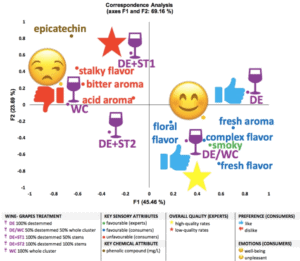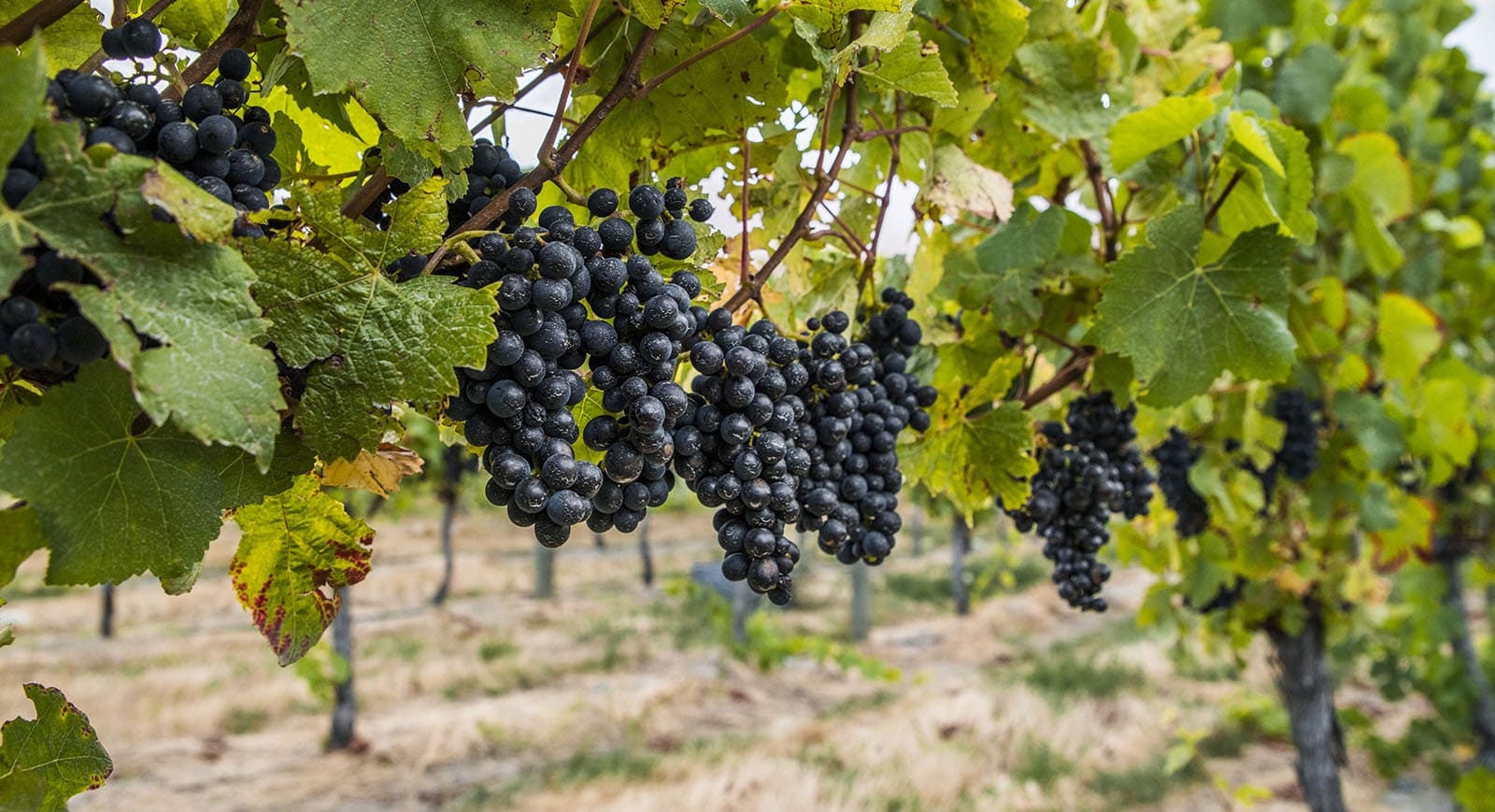Amalia Bernardes Borssato, Damir Dennis Torrico, Leandro Dias Araujo (Lincoln University)

Amalia Borssato
Changing the ratios of whole clusters and stem inclusions in the fermentation process is a well-known winemaking technique used in some red wine varieties, including Pinot noir. In contrast with the conventional method of using destemmed grapes, this practice became popular for improving the tannin structure, aromatic complexity, and freshness of the final wines. However, stems can also elicit other green and herbaceous characteristics, which can affect both expert evaluations and consumer preferences of the product.
The existence of these attributes is dependent on many factors, such as the quantities of berries and stems used in the winemaking process, the method of their incorporation during fermentation, and the chemical interactions occurring after bottling.
Currently, there are no studies specifically dedicated to understanding the potential impact of whole cluster and stem inclusion usage on the chemical and sensory characteristics of New Zealand Pinot noir wines concerning their quality and preference. This article aims to share novel insights from the PhD research project of Amalia Borssato, focused on understanding the nuances of green and herbaceous attributes in New Zealand Pinot noir wines.
Methodology
Five treatments of New Zealand Pinot noir wines were produced at Lincoln University, each subjected to a different process. The treatments used were: (1) conventional method of destemmed grapes (DE), (2) destemmed grapes blended with whole clusters inclusions (DE/WC), (3) destemmed grapes with moderate amount of stems inclusion (DE+ST1), (4) destemmed with high amount of stems inclusion (DE+ST2), and (5) exclusively whole clusters inclusions (WC). Experts with professional backgrounds in the wine sector (n=20) and enthusiasts who consume wine at least occasionally (consumers, n=104), meeting legal age requirements and research ethics standards for sensory evaluation, were recruited for this study. Experts and consumers used the check all that apply (CATA) method to assess the five wine treatments. CATA consists of participants selecting applicable options on a list of attributes (or emotions) according to their sensory perceptions for each treatment during the tasting. Both groups received a list of attributes focusing on green and herbaceous nuances. An additional ‘emoji’ list was presented to consumers aiming to explore the impact of their emotions on preferences.
Evaluation of the wine overall quality and liking
The experts (n=20) rated the overall quality of wines using a 9-point intensity scale, ranging from ‘low quality’ to’ high quality’. After smelling and sipping each sample, they indicated their perception of the wine’s overall quality on the scale. On the other hand, the consumers (n=104) rated the overall liking of the wines using a 9-point hedonic scale, ranging from ‘dislike very much’ to ‘like very much’. After smelling and sipping each sample, they indicated their perception of the wine’s overall liking on the scale. Additionally, Ultra-Performance Liquid Chromatography (UPLC) and Gas Chromatography-Mass Spectrometry (GCMS) were employed to identify and quantify aroma and flavour chemical components of the wines related to the sensory attributes.
Statistical analysis
The Correspondence Analysis (CA) multivariate statistical explored relationships among aromatic compound concentrations, sensory attributes, overall liking, overall quality, and emotions across the five Pinot noir wines. Among fifty-six significant measurements, eleven key variables were selected for representation in the bi-plot analysis using the variables’ strong associations (cosine square values between ±0.707 and ±1.000) with wine quality and acceptability scores.
 Key findings
Key findings
Influence of grape treatments on wine characteristics
Our study reveals the effects of whole clusters and stem inclusions in the fermentation process on the sensory characteristics of New Zealand Pinot noir wines, as perceived by consumers and experts. A complete grape destemming practice demonstrates the potential to introduce fresh aromas to Pinot noir wines, especially when combined with moderate whole cluster inclusions, adding complexity, floral notes, and a distinct smoky bouquet flavour. On the other hand, wines, when exclusively produced from whole cluster inclusions, exhibit pronounced bitterness, acidity, and stalkiness. A similar trend was observed in wines with a moderate proportion of stem inclusion, which were strongly associated with higher concentrations of phenolic compounds, especially epicatechin. Interestingly, high stems inclusion does not show a significant relationship with the key sensory aspects.
Relationship between epicatechin and wine quality and preference
The interplay between grape components and processing techniques is important in shaping the final composition of Pinot noir wines. For instance, phenolic compounds such as epicatechin are responsible for bitterness, which can have a significant effect on the wine quality. In this research, the Correspondence Analysis (CA) highlights the potential adverse impact of high epicatechin concentrations on quality, especially in wines exclusively using whole clusters inclusions (WC). Surprisingly, wines with moderate whole cluster inclusions (DE/WC) did not have high epicatechin concentrations compared to the other wine treatments. This resulted in these wines having a higher acceptability among consumers. The significant presence of this compound, particularly in wines with moderate stem inclusions, not only correlated with unfavourable sensory attributes in the product, but also with unpleasant sensations for consumers, and lower quality ratings expressed by wine experts.
Impact of moderate whole cluster inclusion on wine quality and preference
The prominent presence of the “smoky” attribute in Pinot noir wines with moderate whole cluster inclusions, aligns with the positive association between smoky notes and the perception of sensory complexity. Previous studies indicate that the presence of compounds related to smoky aromas, such as lignin and volatile phenols, contributes to the impression of sophistication and quality in red wines. Additionally, the consistent correlation between flavour complexity perceived by consumers and the perception of quality by experts helps to understand the “smoky” attribute importance on the overall appreciation of the wine.
Influence of emotions on consumer preference
The interaction between consumer perceptions and emotions is a contributing factor in wine preferences. Emphasising attributes such as freshness and floral flavours had a positive effect on emotions. In contrast, the effects of bitterness and stalky were drivers of unpleasant emotions. The positive or negative perception of aromas by the olfactory system is closely linked to the limbic system, which plays an essential role in forming emotional memories associated with these aromas. Thus, elements that evoke negative emotions can decrease the likelihood of purchasing a wine in the future, while positive emotions not only shape immediate perceptions but also forge lasting connections with the product.
Conclusions and implications
In conclusion, this study validates important links in various aspects of Pinot noir wines, such as their quality, chemical compositions, sensory, and emotional impacts. It provides evidence to enhance winemaking practices and consumer experiences. As we collect more data, we aim to draw broader conclusions useful for the wine industry and enthusiasts. This study offers insights into wine perception dynamics, potentially guiding the industry in understanding the connections of whole cluster and stem inclusions with the quality of wines. Addressing these factors is key to producing wines with high quality and acceptability.
About the project
This three year project aimed to identify ‘green’ and ‘herbaceous’ notes in New Zealand Pinot noir wines that drive judgements of high or low quality. This PhD project was conducted within the Department of Wine, Food and Molecular Biosciences of the Faculty of Agriculture and Life
Sciences at Lincoln University, and it is supported by Bragato Research Institute. It was funded by the Pinot Noir Programme and New Zealand Winegrowers levies.

















